A mass for asymptotically complex hyperbolic manifolds
A mass for asymptotically complex hyperbolic manifolds
A mass for asymptotically complex hyperbolic manifolds
You also want an ePaper? Increase the reach of your titles
YUMPU automatically turns print PDFs into web optimized ePapers that Google loves.
hal-00429306, version 1 - 2 Nov 2009<br />
A MASS FOR ASYMPTOTICALLY COMPLEX HYPERBOLIC MANIFOLDS. 7<br />
<strong>hyperbolic</strong> geometry, in complete analogy with the real <strong>hyperbolic</strong> connection ∇RH described in section 1. This is given by the following definition. The Kähler <strong>for</strong>m is<br />
denoted by Ω := g(.,J.). We will often identify vectors and covectors thanks to the<br />
metric g. With our convention, if (e1,Je1,...,em,Jem) is an orthonormal basis, then<br />
Ω = m<br />
Jek ∧ ek.<br />
k=1<br />
Definition 2.1 — Let E := Λ2 JM ⊕ T ∗M ⊕ R be the vector bundle obtained as the<br />
direct sum of the bundle Λ2 JM of J-invariant 2-<strong>for</strong>ms, of the cotangent bundle and of<br />
the trivial (real) line bundle. We endow E with the connection ∇CH defined by<br />
∇ CH<br />
⎛<br />
⎝<br />
X<br />
ξ<br />
⎞ ⎛<br />
α⎠<br />
:= ⎝<br />
u<br />
∇g<br />
1<br />
Xξ + 2 (X ∧ α + JX ∧ Jα)<br />
∇ g<br />
Xα + 2ιX(ξ<br />
⎞<br />
+ uΩ) ⎠ .<br />
dXu + Jα(X)<br />
The connection ∇ CH preserves a pseudo-Riemannian structure h on E, with signature<br />
(m2 + 1,2m) and given by h(ξ,α,u) = |ξ| 2<br />
g + u2 − |α|2 g<br />
2 .<br />
This connection ∇ CH is very related to the study of Hamiltonian two-<strong>for</strong>ms in [ACG],<br />
where a similar but more sophisticated connection is introduced. Let us explain why<br />
this connection is natural. In analogy with section 1, we expect its curvature to measure<br />
the deviation from the <strong>complex</strong> <strong>hyperbolic</strong> geometry (in the spirit of Cartan’s connections).<br />
In order to write down an explicit <strong>for</strong>mula <strong>for</strong> the curvature, we introduce an<br />
algebraic operation : if X and Y are two vectors and γ is an exterior <strong>for</strong>m, we set:<br />
CX,Y (γ) := (X ∧ ιY γ − Y ∧ ιXγ) + (JX ∧ ιJY γ − JY ∧ ιJXγ).<br />
Proposition 2.2 — The curvature of ∇CH is given by<br />
⎛<br />
Rm ∇CH<br />
X,Y =<br />
⎝<br />
Rm ∇ X,Y −CX,Y 0 0<br />
0 Rm∇ X,Y − [2Ω(X,Y )J + CX,Y ] 0⎠<br />
.<br />
0 0 0<br />
It follows that Rm∇CH vanishes if and only if the holomorphic sectional curvature is<br />
−4. In other words, (EM, ∇CH ) is flat if and only if the universal cover of (Mm ,g,J)<br />
is the <strong>complex</strong> <strong>hyperbolic</strong> space CHm of holomorphic sectional curvature −4.<br />
The proof of this <strong>for</strong>mula is a straight<strong>for</strong>ward computation, which we omit. The link<br />
with the curvature of the <strong>complex</strong> <strong>hyperbolic</strong> space is explained in paragraph IX.7 of<br />
[KN] (where the sign convention is the opposite of ours).<br />
Remark 4. By changing ∇ g<br />
Xα + 2ιX(ξ + uΩ) into ∇ g<br />
Xα − 2cιX(ξ + uΩ) in the <strong>for</strong>mula<br />
<strong>for</strong> the connection, it is possible to obtain a family of connections characterizing every<br />
constant holomorphic curvature 4c (in particular : <strong>complex</strong> projective spaces).<br />
The parallel sections (ξ,α,u) <strong>for</strong> ∇ CH obey α = Jdu and ξ = − 1<br />
2 ∇g α − uΩ so<br />
that they are determined by their third component u, which satisfies the third order<br />
equation<br />
∀ X ∈ TM, ∇ g<br />
X Hessg u = 2du(X) + X ⊙ du + JX ⊙ Jdu,<br />
where a ⊙ b means a ⊗ b + b ⊗ a. We will denote by N the space of parallel sections of<br />
(E, ∇ CH ). We will also need the subspace<br />
(6) N0 := {(ξ,α,u) ∈ N / g(ξ,Ω) = u}<br />
⎞


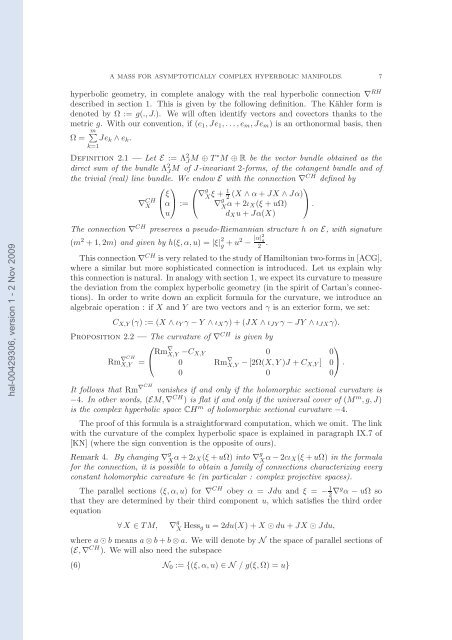

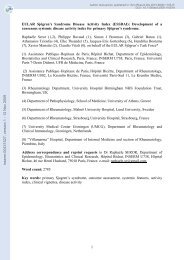
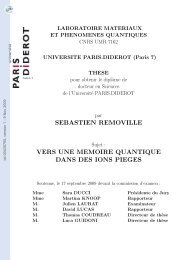
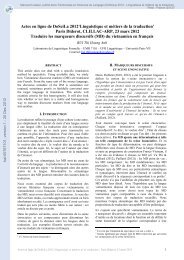
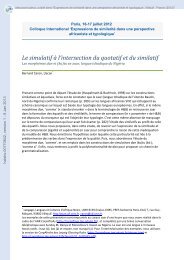
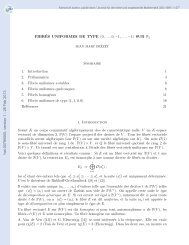
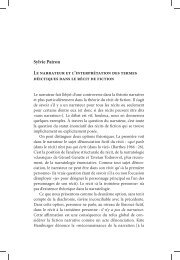
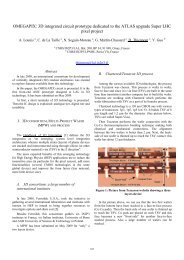
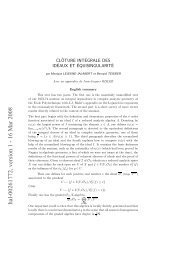
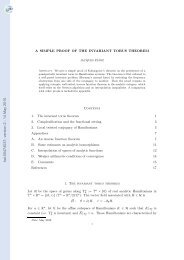

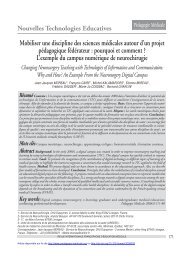

![[tel-00433556, v1] Relation entre Stress Oxydant et Homéostasie ...](https://img.yumpu.com/19233319/1/184x260/tel-00433556-v1-relation-entre-stress-oxydant-et-homeostasie-.jpg?quality=85)